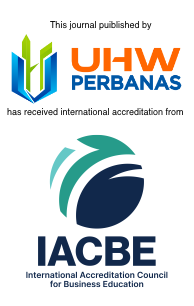Author Guidelines
Please read the guidelines in full before submitting your manuscript.
Manuscripts not conforming to these guidelines may be returned or rejected.
Check if your article aligns with the focus of this journal. The focus of this journal, as indicated by its name, is the Indonesian Accounting Review. Also, showcase the novelty of your research. We prefer to accept high-quality articles that inspire accounting practices in Indonesia or Indonesian-style accounting articles that highlight the uniqueness of Indonesian accounting, which will be presented to a global audience.
The Indonesian Accounting Review takes issues of copyright infringement, plagiarism or other breaches of best practice in publication very seriously. We Seek to protect the rights of our authors and we always investigate claims of plagiarism or misuse of published articles. Equally, we seek to protect the reputation of the journal against malpractice. Submitted articles may be checked with Turnitin duplication-checking software. Where an article, for example, is found to have plagiarised other work or included third-party copyright material without permission or with insufficient acknowledgement, or where the authorship of the article is contested, we reserve the right to take action including, but not limited to: publishing an erratum or corrigendum (correction); retracting the article; taking up the matter with the head of department or dean of the author's institution and/or relevant academic bodies or societies; or taking appropriate legal action.
The author should disclose any prior distribution and/or publication of any portion of the material to the Editor for the Editor’s consideration and ensure that appropriate attribution to the prior distribution and/or publication of the material is included.
STYLE OF WRITING
- Articles should be typed on A4 paper submitted in soft copy.For templates and information about formatting, manuscript organization, manuscript components, web appendices, references, and more, see Article template can be downloaded here
- For blind review, the title and identity of the writer (name and email address, and/or letter address) are written separatefile from the article.
- Articles should not exceed 7.000 words or it is between 15-20 pages, 11 font of Book Antiqua, in one space, including the references, figures, and tables.
- Left, right, top, and bottom margin are about 1 inch
- Quotation, pictures or references should show the resources and year. Name, year, and page are stated if it is from the book, in which all should be consistently the same as listed in the references.
- References are preferably 80% taken from the up-to-date references or the past 5-year publication copy right date.
- The number of pages should be on the bottom with central position.
- No and title of the tables or pictures are written above the tables but the names of the figure should be typed under figures, bold typed, and the titles should be placed under the no of tables or pictures.
- Include the sources of tables and pictures underneath.
- Include the author biography separately: it should tell home address, institution, phone no that can be easily contacted, education background, some titles of recent publications or research activities, field of education, and interest of the research, as well as work experience or organizational activities.
GUIDE OF WRITING
Your article title, keywords, and abstract all contribute to its position in search engine results, directly affecting the number of people who see your work.
The framework of writing the articles are as the following: (1) title, (2) abstract, (3) introduction, (4) literature review as theoretical framework and hypothesis (if any), (5) research method, (6) data analysis, and discussion, (7) conclusion, implication, suggestion, and limitation(8) references, and (9) appendices. The details are as the following.
Title of the Article
The Tittle should reflect the content, and use the words, terms, abbreviations, formulas, registers as commonly used in the research writing. Your manuscript’s title should be concise, descriptive, unambiguous, accurate, and reflect the precise contents of the manuscript. A descriptive title that includes the topic of the manuscript makes an article more findable in the major indexing services.
To ensure fair and anonymous peer review, your manuscript must be fully anonymized. Please ensure any identifying information is removed from the main manuscript document Do not include any author names in the manuscript file name and remove names from headers and footers. This version of the manuscript will be sent to the peer reviewers.
Submitting an article through OJS demands your utmost attention to detail. It is imperative that you meticulously follow each step, ensuring that both the form and your documents are precisely adjusted as per OJS requirements. For the blind review process, it is crucial to remove the author's name before submission. Failure to do so will result in automatic rejection. Adhering to these guidelines is not just a recommendation; it is essential for the successful consideration of your work.
Clearly fill in your personal details (including a brief biography and email) in the form when you first submit the article. Also provide the order of authors (if there is more than one) and their email addresses as well as brief biographies of all authors, or send them in a separate file.
Abstract
An abstract is a concise summary of a research paper, typically ranging from 150 to 200 words. It should clearly outline the research topic or problem, the purpose of the study, the methods employed, the key findings or results, and the implications of the research. The abstract serves as a snapshot of the entire paper, providing readers with a quick understanding of the study's scope and significance. It is crucial to ensure that the abstract is well-structured and informative, as it often determines whether readers will delve deeper into the full paper. Additionally, the abstract should be written in a clear and concise manner, using appropriate terminology and avoiding unnecessary jargon. Proper formatting, such as justified pagination and the use of a specific font like Book Antigua size 11, can enhance the readability and professional appearance of the abstract. Including relevant keywords, typically 3 to 5, can also aid in the discoverability of the research in databases and search engines.'
Keywords: Please include a minimum of 3 keywords, listed after the abstract. Keywords should be as specific as possible to the research topic.
Introduction
Introduction should be about one page, containing the background, reasons to do the research, problem formulation, purpose of the research and without sub-heading, bullets, or numbering.
Theoretical Framework and Hypothesis (If Any)
It describes the previously related studies as the primary sources. The use of secondary sources of references should not dominate the total references. Quotation should be maximally one paragraph and/ or the gist of the quoted sources.
Research Method
It comprises the procedures or steps of the research, e.g., from the methods of sampling to the data analysis, and presented in brief and concisely by numbering.
Data Analysis and Discussion
A research article is not a research report. Avoid copy-pasting statistical test tables directly into the text. Tables or figures are better described clearly, unless necessary.
It presents the analysis of the related results, theories, and hypotheses (if any) based on the writers reasoning. Data analysis and discussion should be presented in brief but clear and it is not dominated by table presentation. The tables which are presented should not be the rough output but in the processed and brief summary. Tables and pictures are presented consistently in the center and the titles are above the tables, exept the names of the figures, they should be typed under the Figures.
Conclusion, Implication, Suggestions, and Limitations
It is the closing of the article which reflects the essence and reasoning of the research by the writer. It is also logically based on the evidence taken from, and presented by the author in paragraphs. Implication, limitations, and suggestions are also presented in paragraphs without numbering.
Acknowledgement
Write a thank you note if you have received funding for this research and where you obtained the funds.
If you are including an Acknowledgements section, this will be published at the end of your article. The Acknowledgments section should include all contributors who do not meet the criteria for authorship.
Declaration of generative AI use
The use of AI tools in the manuscript preparation process must be disclosed and announced by adding a statement at the end of the manuscript when the paper is first submitted to the TIAR journal. The statement will appear in the published work and must be placed in a new section before the reference list. If the author is known to use AI but does not include a statement about its use, the author is considered to have violated the integrity and publication policy of the TIAR journal and the submitted article may be rejected for publication.
References
For templates and information about formatting, manuscript organization, manuscript components, web appendices, and references, see the APA Style Reference Example
Every in-text citation must have a corresponding citation in the reference list and vice versa. Corresponding citations must have identical spelling and year.
Use references from the last approximately 5 years, 80% of which should refer to credible Scopus-indexed journals. Also display the DOI reference identity of each article you use as a reference. This is to store cross-linked data Crossref.
Appendices
Appendices consist of research instruments, supporting data, pictures, and others that support the articles and help readers understand the research articles.
Tables and Figures
Tables should be the processed one which are included in the text without vertical lines (and only three horizontal lines). When they are too big sizes they should be put in Apenndices. The title names are typed above the tables. Figures should also be put in the text when the sizes are not too big and the title names are typed under the Figures.
Author Biography
Create a comprehensive biography for each author and send it in a separate file from the manuscript. For each author, it is mandatory to include Biography, Full Name, Email Address, Institutional/University Affiliation, and ORCID Number (You can register for free at the website https://orcid.org)
To become more familiar with The Indonesian Accounting Review, please refer to Our Policy Section:
Publication Ethics Policy | Plagiarism Policy | Open Acces Policy | Peer Review Process | Crossmark Policy | Copyright Notice | Privacy Statement

















